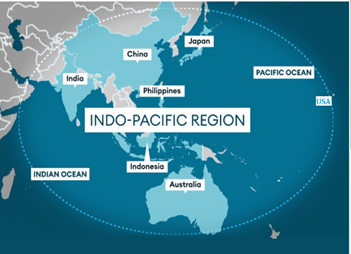Mains Daily Question
March 21, 2023
Explain the strategic importance of the Indo-Pacific region to India. Also, mention the initiatives taken by India in order to strengthen its position in the Indo-Pacific region.
Approach:
Introduction: Define what is meant by the term "Indo-Pacific region."
Body. Discuss the strategic significance of the Indo-Pacific region for India. Mention the various steps that have been taken by the Indian government to strengthen its position in the Indo-Pacific.
Conclusion. Mention the steps that India needs to take to strengthen its role in the region.
Answer:
The Indo-Pacific is a geopolitical construct that has emerged as a substitute for the long-prevalent “Asia-Pacific”. However, different nations have a different understanding of the region, as the U.S.A. considers that the region extends from the coastlines of the Indian subcontinent to the western shore of the Americas, whereas India and Japan, consider that the region extends to the African continent’s coasts as well.
The strategic significance of the Indo-Pacific region for India:
- Geo-political aspirations -As Indo-Pacific is a multipolar region that is home to more than half of the world's population and GDP. So, a stable, safe, and prosperous Indo-Pacific Region is an important part of India's strategic partnership with other countries, especially the US, and is crucial for India as it wishes to expand its influence in the region, especially in Africa, the Middle East and Southeast Asia by emerging as a net security provider in the region.
- Mineral Resources: The Indo-Pacific region is home to important resources like offshore hydrocarbons, methane hydrates, seabed minerals, rare earth metals, etc. The South China Sea, for example, is thought to hold 11 billion barrels of oil and 190 trillion cubic feet (tcf) of gas, as well as 10% of the world's fish catch and 10% of the world's gas. Thus, India is also interested in sustainable mineral exploration in the region e.g., Samudrayaan Mission.
- Economic Growth: A report from the Asian Development Bank (ADB) says that countries in the Indo-Pacific produce more than 60 percent of the world's gross domestic product (GDP). This makes the Indo-Pacific the biggest single contributor to global growth.
- Important sea lanes of communication: Many of the world's most important choke points for global trade are in this area, including the Straits of Malacca Bab-el-Mandeb and Lombok Strait, which are very important for the growth of the world economy. The Indo-Pacific region is also a hub for international trade. About 32,2 million barrels of crude oil pass through the area every year, and 40% of the world's exports come from the area. Also, 90% of India’s trade and its energy supplies are transported via the Indian Ocean, thus India is taking steps to establish a rules-based order in the region.
- Countering China - Given that China continues to exert its influence in the region through its Belt and Road Initiative and as China is increasing its proximity to the vital choke points by developing Gwadar (Pakistan) and Hambantota (Sri Lanka). These acts of China are leading toward the militarization of the region. So, to establish a rules-based order in the region, India needs to counter China by emerging as the net security provider in the region.
The government’s steps to strengthen its position in the region:
- Foreign Policy and Initiatives-
- Indo-Pacific Division: This division was established in 2019 to give a coherent architecture to India’s Indo-Pacific policy.
- Collaboration with Regional summits: India is collaborating with various regional groups such as IOC-ARC, and ASEAN, on a multitude of subjects. India has joined QUAD and Indo Pacific Economic Framework. Various groups in QUAD are working on collaboration in emerging technologies to ensure more cooperation
- Initiatives to increase cooperation: Indian Ocean Naval Symposium (increase maritime cooperation), and Asia Africa Growth Corridor (for development and cooperation projects) were taken up.
- Environmental initiatives: e.g. International Solar Alliance (ISA) and Coalition for Disaster Resilient Infrastructure (CDRI), are enabling India to realize its idea of sustainable growth in the Indo-Pacific region.
- Regional Policies aligning with the vision of Indo Pacific such as:
- Vision SAGAR: With its intent to promote security and growth for all in the Region, it would enable India to promote its geo-political, strategic, and economic interests.
- Project Mausam: It aims to understand how the knowledge and manipulation of the monsoon winds have shaped interactions across the Indian Ocean and have led to sharing of knowledge systems and ideas along maritime routes.
- Supply chain resilience initiative: To create a virtuous cycle of supply chain re-silence in the region by reducing our dependence on China.
The geopolitical advantage has already put India in a pre-eminent position. However, new areas of cooperation will have to be identified, for example, by formulating multilateral diplomacy, and blue water policies and encouraging deeper economic integration through free trade agreements (FTAs), in order to give greater content and strength to the regional and bilateral partnerships in the region. This will provide traction for growth, development, and security for India and the countries in the Indo-Pacific region as a whole.


